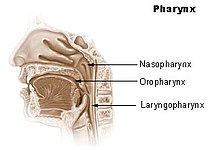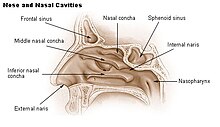Nasopharynx
The nasopharynx ( Greek for nasopharynx ), also nasopharynx ( epipharynx , pars nasalis pharyngis or rhinopharynx ), is a part of the throat .
Anatomy of the nasopharynx

The nasopharynx is located behind the main nasal cavity , above the level of the soft palate and below the base of the skull . It communicates with the nasal cavity through the opening of the choan . In the side wall, in humans about 1 cm behind the end of the inferior turbinate, the tube opening (ostium pharyngeum tubae auditivae) , the entrance to the eustachian tube (ear trumpet) , is located on both sides . There, lymphatic tissue is embedded in the mucous membrane, which is known as the tubal tonsil . The cartilage of the eustachian tube forms a bulge of the mucous membrane called the torus tubarius . This bulge continues downward as the plica salpingopharyngea (tube-pharynx fold), under which the salpingopharyngeal muscle runs. The flat plica salpingopalatina (tube-palate fold) extends from the anterior tube ostium towards the soft palate . Behind the torus tubarius there is a flat pocket of the mucous membrane, the recessus pharyngeus (Rosenmüller pit). The unpaired pharyngeal tonsil lies in the center of the posterior wall of the nasopharynx .
When swallowing, the nasopharynx is closed by the soft palate, the uvula and the posterior palatal arch (arcus palatopharyngeus) against the pharynx so that food and drinks cannot get into the nose.
Diseases of the nasopharynx
- Tornwaldt cysts (pharyngeal bursitis) , a rare, often chronic inflammation of the pharyngeal bursa , which may be accompanied by cyst formation
- Hyperplastic pharyngeal tonsils ( adenoids )
- Inflammation of the tonsils ( adenoiditis )
- Choanal polyp (nasal polyp)
- Benign tumors, such as a juvenile nasopharynx fibroma
- Nasopharyngeal carcinoma .
Individual evidence
- ↑ a b Walther Graumann, Dieter Sasse (Ed.): Compact textbook anatomy . tape 3 : Internal organ systems . Schattauer, Stuttgart 2004, ISBN 3-7945-2063-7 , p. 53-55 .

